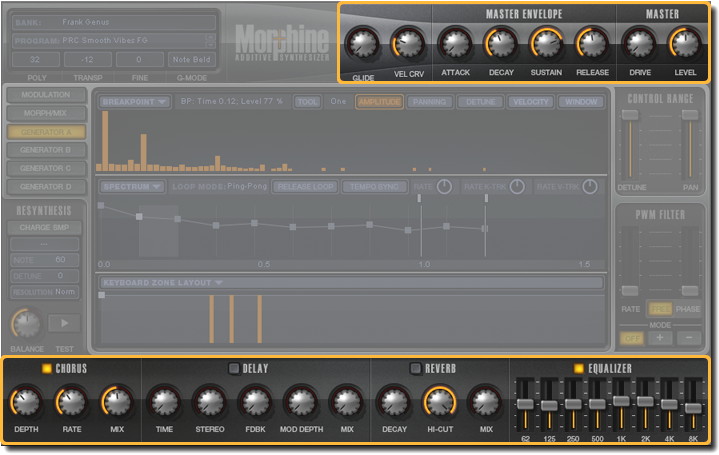INSTRUMENTS / GENERATORS
Envelopes & Effects Panels

Morphine Envelopes & Effects
The following are Global controls and affect all Generators.
- GLIDE - Glide-time. Slide between notes. NOTE: There are Glide Mode options on the General Settings panel.
- VEL CRV (Velocity Curve) - Left (0%) decreases velocity sensitivity, right (100%) increases velocity sensitivity.
MASTER ENVELOPE
The Master ADSR controls are imposed over the Generator volume dynamics.
- ATTACK - Note onset attack time.
- DECAY - Decay time from peak (Sustain) level.
- SUSTAIN - Peak Sustain level.
- RELEASE - Decay time after the note is released.
NOTE: If the Generators already have slow attacks then adjusting the Master attack to minimum can't create a fast attack sound. To change the volume dynamics of the Generators adjust the shape of the Spectrum for each Generator (see the tutorial on ADSR at the bottom of the Generator Page).
MASTER (Amp)
- DRIVE - Distortion sound.
- LEVEL - Master volume level.
Effects
Each Effect has a switch so that it can be turned ON/OFF. In the screen-shot above the Chorus and Equalizer are on, all other effects are off.
CHORUS
- DEPTH - Chorus depth/intensity.
- RATE - Chorus speed.
- MIX - Chorus mix level (0% to 100%).
DELAY
- TIME - Delay time (2 ms to 999 ms).
- STEREO - Creates a stereo ping-pong effect. First ping direction (Left or Right) is controlled by the direction of the knob.
- FDBK (Feedback) - Delay feedback level. More feedback creates a greater number of echoes.
- MOD DEPTH (Modulation Depth) - Adds a modulation offset to the delay time to create more complex echoes.
- MIX - Delay mix level (0% to 100%).
REVERB
- DECAY - Decay time. Turn the knob to the right to simulate a larger space, left smaller.
- HI-CUT - Amount of high-frequency damping to the reverb. Turning to the right simulates a 'brighter' space, left 'dull'.
- MIX - Reverb mix level (0% to 100%).
EQUALIZER
8 band Graphic Equalizer with +/- 12 dB of boost/cut.
NOTE: If you need to EQ, rather than boosting the parts of the spectrum you want louder, cut the parts of the spectrum you don't want instead. While these two options sound the same in isolation, cutting unwanted frequencies ensures the sound will sit better in a mix. This works because the frequency energy from the unwanted (cut) parts no longer interferes with neighbouring sounds in the mix. The result is better clarity and more headroom.
